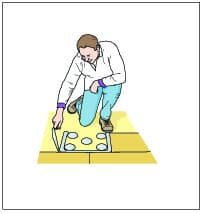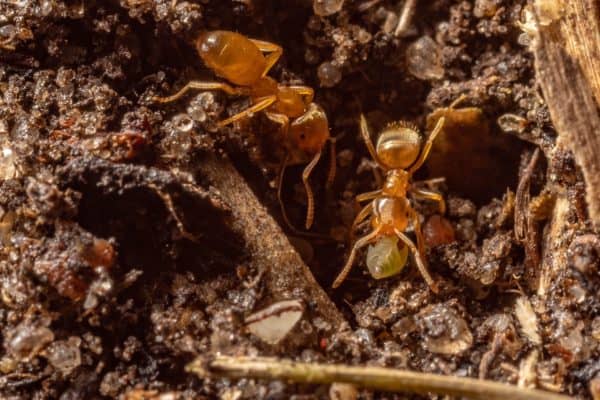Spot bedding is one of the most commonly known methods for laying all kinds of paving, including natural stone paving like ours. It has been ubiquitous for many years now and continues to be used widely. So why shouldn’t you use it too? Let’s take a look.
What is spot bedding?
For those out of the loop, spot bedding is the method of using 4 or 5 “dabs” or “blobs” of mortar under each flag like the spots on dice, sometimes with a line around the four edges mainly to use for pointing.
It’s simple, quick and easy – a tempting proposition for the inexperienced DIY-er or less than reputable contractor. But while it seems fine on the face of things, it will leave your patio or driveway open to all kinds of problems in the long term.
Stability
Imagine those four spots of mortar, one in each corner of your flag. It only takes one of those 4 spots to lose a little bit of stability and bang – you’ve got a wobbler. And with all that empty space between the spots down there, there’s plenty of room for surface water to accumulate and start shifting things around underneath the flagstones.
You are probably familiar with the idea of subsidence for a building, but even a small patio is a construction in itself and is equally prone to subside if its foundations are not strong enough.
Wildlife

You know what else likes nice empty, dark, covered spaces underground? Mice, rats, ants, and any number of critters would be more than happy to call those small, safe cavities home, digging their tunnels and nests and doing whatever else it is that the world of rodents and insects do.
It follows that any activities like that going on under your paving will compromise the stability of the ground underneath leading to the same problems and the dreaded wobblers.
Strength
Natural stone paving is physically a fairly strong material, with the standard thicknesses more than suitable for all kinds of foot traffic. But it stands to reason that if it is supported underneath in some spots but not others then you are creating weaker areas which could be prone to cracking under a heavy load.
Reflective Staining
Porous might not be the first word that comes to mind when you think of stone, but all natural stone is porous to some degree and therefore can be stained. For example, when laying the flags any mortar spilling onto the top surface of the paving should be immediately cleaned off (just soapy water is fine) otherwise the wet mixture can leave an unsightly stain.

Reflective staining is a special term for a type of stain that appears on the surface of the paving because of something causing it from below. It “reflects” what is under it.
If you spot bed your natural stone paving, obviously some of the stone has mortar under it and some has just air. This creates two different environments within the area of the same flag. Just as a candle wick draws the wax up through itself, your mortar spots will do the same with moisture and any salts or minerals that are carried with it. These salts and minerals will leech through the stone only in the spots with mortar underneath, leaving unwanted and ugly stains on the surface of your beautiful paving which are often impossible to get rid of.
Cost
Given all of the issues spot bedding can give you in the future, the idea that spot bedding is cheaper because it uses less mortar or saves a few quid on labour time is a fallacy. You are bound to need to do some remedial work a few months or years down the line which will cost you more and potentially leave you with noticeable repairs (like different ages of joints where you’ve lifted and re-laid a wobbly flag).
Do it properly the first time!
So what method should you use?
All of these reasons together make it clear – spot bedding is simply not at all suitable for natural stone paving.
The correct way for natural stone paving is individual bedding. This conforms to BS (British Standard) 7533-4 which requires a “full bedding layer” pavements, patios and driveways laid with natural stone paving.
Individual bedding is making a full and complete layer of mortar for each flag as you go along. This allows for the variations in thickness present in natural stone which is not present in manufactured units like concrete (where screed bedding is a suitable method) and means each flag is fully supported to its individual needs while maintaining a nice flat surface across the project.
No gaps for water to accumulate, critters to congregate, or minerals to be stuck behind.
We hope this guide has been helpful. If you have any questions about this guide or need any further advice in planning your project please feel free to get in touch here and our expert team will be happy to help.
